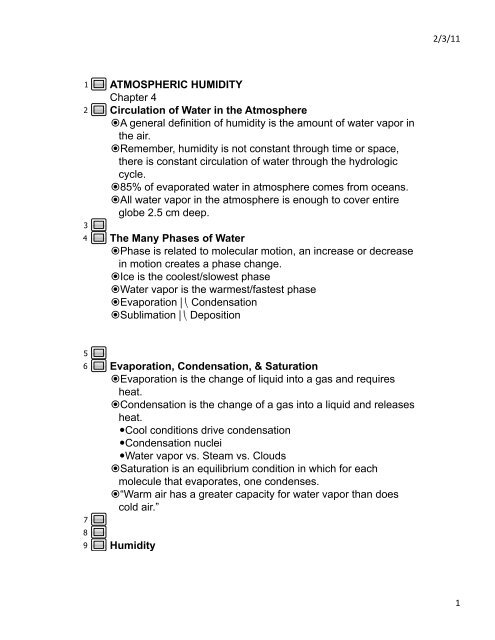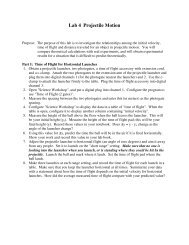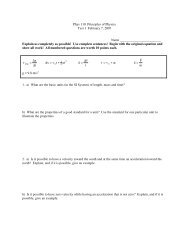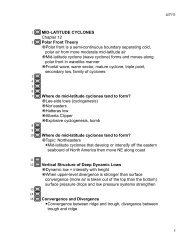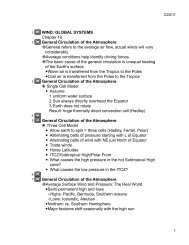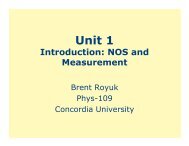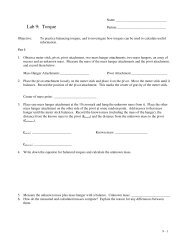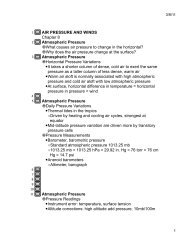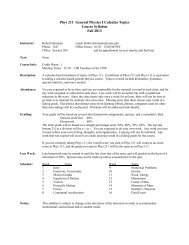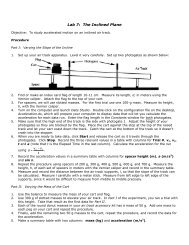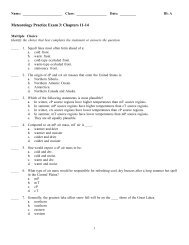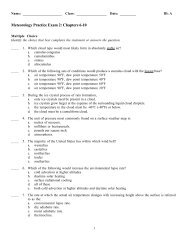ATMOSPHERIC HUMIDITY Chapter 4 Circulation of Water in the ...
ATMOSPHERIC HUMIDITY Chapter 4 Circulation of Water in the ...
ATMOSPHERIC HUMIDITY Chapter 4 Circulation of Water in the ...
You also want an ePaper? Increase the reach of your titles
YUMPU automatically turns print PDFs into web optimized ePapers that Google loves.
2/3/11 1234<strong>ATMOSPHERIC</strong> <strong>HUMIDITY</strong><strong>Chapter</strong> 4<strong>Circulation</strong> <strong>of</strong> <strong>Water</strong> <strong>in</strong> <strong>the</strong> Atmosphere A general def<strong>in</strong>ition <strong>of</strong> humidity is <strong>the</strong> amount <strong>of</strong> water vapor <strong>in</strong><strong>the</strong> air. Remember, humidity is not constant through time or space,<strong>the</strong>re is constant circulation <strong>of</strong> water through <strong>the</strong> hydrologiccycle. 85% <strong>of</strong> evaporated water <strong>in</strong> atmosphere comes from oceans. All water vapor <strong>in</strong> <strong>the</strong> atmosphere is enough to cover entireglobe 2.5 cm deep.The Many Phases <strong>of</strong> <strong>Water</strong> Phase is related to molecular motion, an <strong>in</strong>crease or decrease<strong>in</strong> motion creates a phase change. Ice is <strong>the</strong> coolest/slowest phase <strong>Water</strong> vapor is <strong>the</strong> warmest/fastest phase Evaporation ⎜⎜⎝⎝ Condensation Sublimation ⎜⎜⎝⎝ Deposition56789Evaporation, Condensation, & Saturation Evaporation is <strong>the</strong> change <strong>of</strong> liquid <strong>in</strong>to a gas and requiresheat. Condensation is <strong>the</strong> change <strong>of</strong> a gas <strong>in</strong>to a liquid and releasesheat. Cool conditions drive condensation Condensation nuclei <strong>Water</strong> vapor vs. Steam vs. Clouds Saturation is an equilibrium condition <strong>in</strong> which for eachmolecule that evaporates, one condenses. “Warm air has a greater capacity for water vapor than doescold air.”Humidity Any <strong>of</strong> a number <strong>of</strong> ways <strong>of</strong> specify<strong>in</strong>g <strong>the</strong> amount <strong>of</strong> water1
7891011121314151617Humidity Any <strong>of</strong> a number <strong>of</strong> ways <strong>of</strong> specify<strong>in</strong>g <strong>the</strong> amount <strong>of</strong> watervapor <strong>in</strong> <strong>the</strong> air. Units: g/cm 3 AKA <strong>Water</strong> vapor density Not commonly used due to frequent change <strong>of</strong> volumeHumidity Specific Humidity: mass <strong>of</strong> water vapor/mass <strong>of</strong> air Mix<strong>in</strong>g ratio: mass <strong>of</strong> water vapor/mass <strong>of</strong> dry air Units: g/kg Nei<strong>the</strong>r measurement changes with volume, must add orsubtract water vapor to change. This makes <strong>the</strong>se concepts much more useful.Humidity Vapor pressure: <strong>the</strong> pressure exerted by water vapormolecules <strong>in</strong> an air parcel (Dalton’s Law <strong>of</strong> Partial Pressure) Fraction <strong>of</strong> total vapor pressure (1% or so) More water molecules = high vapor pressure Saturation vapor pressure: <strong>the</strong> vapor pressure at which an airparcel will be saturated, changes with temperatureHumidity Special Topic: Vapor Pressure & Boil<strong>in</strong>g Once water boils it requires more energy to <strong>in</strong>creasetemperature. Boil<strong>in</strong>g occurs when <strong>the</strong> saturation vapor pressure equalsatmospheric pressure. <strong>Water</strong> boils at a low temperature <strong>in</strong> <strong>the</strong> mounta<strong>in</strong>s and thusneeds more energy and time to cook items as compared tosea level.Humidity Relative Humidity: (actual water vapor/saturation water vapor)*1002/3/11 2
1617 Relative Humidity: (actual water vapor/saturation water vapor)*1002/3/11 181920212223242526 RH can be changed two ways:○ Change vapor content○ Change saturation A decrease <strong>in</strong> temperature causes an <strong>in</strong>crease <strong>in</strong> relativehumidity. What does 50% RH mean? 100%?Humidity Temperature Effects For same amount <strong>of</strong> water:○ High temp. decreases RH○ Lower temp. <strong>in</strong>creases RH Low RH means more evap. Don’t water lawns when it’s hot. Polar air is very dry even if <strong>the</strong> RH is near 100%.Dew Po<strong>in</strong>t Dew po<strong>in</strong>t is <strong>the</strong> temperature at which saturation occurs. The temperature to which air would have to be cooled (withno change <strong>in</strong> air pressure or moisture content) for saturationto occur. Cool air parcel to dew po<strong>in</strong>t and liquid water condenses. A good measure <strong>of</strong> actual water vapor content Relative humidity <strong>in</strong>dicates how close to saturation, dewpo<strong>in</strong>t <strong>in</strong>dicates <strong>the</strong> amount <strong>of</strong> water vapor. Large difference between temperature and dew po<strong>in</strong>t meanshigh relative humidity.Dew Po<strong>in</strong>t As <strong>the</strong> sun goes down, a low dew po<strong>in</strong>t means <strong>the</strong> expectedovernight low temperature will be lower. There will be fewer water molecules <strong>in</strong> <strong>the</strong> air to absorb IRenergy from <strong>the</strong> ground.3
22232425262728293031Humidity Relative Humidity <strong>in</strong> <strong>the</strong> Home Due to an <strong>in</strong>crease <strong>in</strong> temperature <strong>of</strong> w<strong>in</strong>ter air brought <strong>in</strong>to aheated home <strong>the</strong>re is a decrease <strong>in</strong> relative humidity, caus<strong>in</strong>gmore evaporation from body, plants, etc○ Humidifier, chapped lips Swamp coolerHumidity Relative humidity & human comfort “It’s not <strong>the</strong> heat, it’s <strong>the</strong> humidity.” High relative humidity equates to less evaporative cool<strong>in</strong>g. Sweat cannot evaporate and cool <strong>the</strong> body Wet bulb temperature○ The lowest temperature that can be reached by evaporat<strong>in</strong>gwater <strong>in</strong>to <strong>the</strong> air. Heat IndexHumidity Special Topic: Heavier humid air Due to <strong>the</strong> molecular weight <strong>of</strong> water as compared tonitrogen, humid air is lighter than dry air.○ N 2 O 2 H 2 O○ Molecular weight <strong>of</strong> dry air: ~29 Baseball announcers are <strong>in</strong>correct.○ “The air today is heavy because <strong>of</strong> <strong>the</strong> high humidity.”Measur<strong>in</strong>g Humidity Sl<strong>in</strong>g psychrometer Wet-bulb depression Appendix D Hygrometer Hair hygrometer (0 to 100%: 2.5% <strong>in</strong>crease) Electrical hygrometer○ Carbon’s resistance changes with humidity Infrared hygrometer○ Measure IR pass<strong>in</strong>g through air sample2/3/11 32334
2/3/11 323334○ Measure IR pass<strong>in</strong>g through air sample Dew-po<strong>in</strong>t hygrometer○ Cools a mirror until liquid condensesHomework for <strong>Chapter</strong> 4 <strong>Chapter</strong> 4 Questions for Review, p. 108 #4, 7, 10-13, 15-17, 19, 21 <strong>Chapter</strong> 4 Questions for Thought, p. 108 #7, 11 <strong>Chapter</strong> 4 Problems and Exercises, p. 109 #3, 6Project for <strong>Chapter</strong> 4 Project 3: Make a l<strong>in</strong>e graph <strong>of</strong> <strong>the</strong> temperature, dew-po<strong>in</strong>tand relative humidity for July 4, 2010 Plot <strong>the</strong> po<strong>in</strong>ts with a vertical axis that varies from 60 to 100. Give <strong>the</strong> graph <strong>the</strong> title July 4, 2010 On <strong>the</strong> graph: Note when it began to ra<strong>in</strong>. When <strong>the</strong> temperature rose <strong>in</strong> <strong>the</strong> afternoon mark <strong>the</strong> drop <strong>in</strong><strong>the</strong> RH and expla<strong>in</strong> why that took place.5


